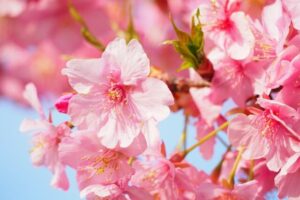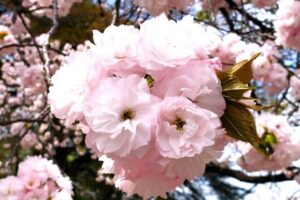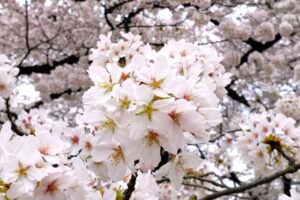外国人から「いなり寿司って何ですか?」と聞かれたら、英語で答えられますでしょうか?
 woman
woman(「いなり寿司」って何ですか?)



いなり寿司って英語で何て説明すればいいのかしら?
外国人にいなり寿司をどうやって説明すればいいのか?
そんな疑問にお答えします。
いなり寿司は英語で「Inari sushi( いなり寿司 )」です。



(いなり寿司は、油揚げの中に酢飯を詰めたお寿司です。)
いなり寿司について英語で説明する例文を一緒に見て行きましょう。
いなり寿司(おいなりさん)を英語で説明
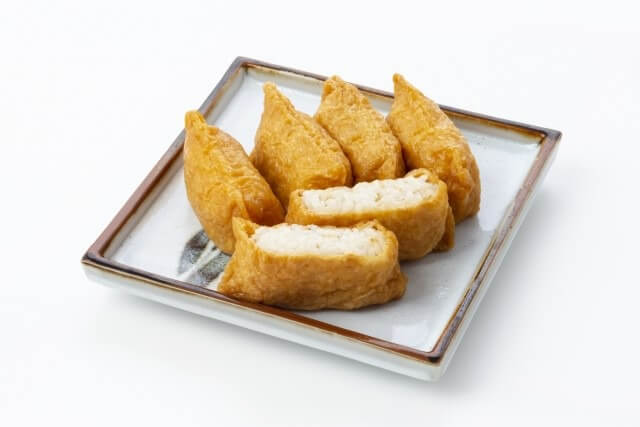

Inari sushi is sushi made by stuffing vinegared rice in fried tofu.
いなり寿司は、油揚げの中に酢飯を詰めたお寿司です。
- Inari sushi/いなり寿司
- sushi/寿司
- made/make(作る)の過去形・過去分詞
- by/~で
- stuff/詰める
- vinegared rice/酢飯
- fried tofu/油揚げ
Inari sushi is made by simmering fried tofu with soy sauce and sugar and stuffing vinegared rice in the fried tofu.
いなり寿司は、油揚げを醤油と砂糖で甘辛く煮つけ、油揚げの中に酢飯を詰めて作ります。
- Inari sushi/いなり寿司
- made/make(作る)の過去形・過去分詞
- by/~で
- simmer/(沸騰寸前の温度で)とろとろ煮る
- fried tofu/油揚げ
- with/~で
- soy sauce/醤油
- sugar/砂糖
- stuff/詰める
- vinegared rice/酢飯
The vinegared rice to be stuffed in Inari sushi may be white vinegared rice or vinegared rice mixed with simmered ingredients.
いなり寿司の中に詰める酢飯は、白い酢飯の場合と、具材を煮て混ぜた酢飯を使う場合があります。
- vinegared rice/酢飯
- stuff/詰める
- Inari sushi/いなり寿司
- may/場合がある
- white/白い
- vinegared rice/酢飯
- mix with/混ぜる
- simmer/(沸騰寸前の温度で)とろとろ煮る
- ingredient/具材
Inari sushi is a relatively cheap food that is often sold at supermarkets and sushi restaurants specializing in takeout.
いなり寿司は、スーパーやテイクアウト専門の寿司屋などで良く売られている、比較的安く買える食べ物です。
- Inari sushi/いなり寿司
- relatively/比較的
- cheap/安い
- food/食べ物
- often/よく
- sold/sell(売る)の過去形・過去分詞
- supermarket/スーパー
- sushi restaurant/寿司
- specialize in/専門に扱う
- takeout/テイクアウト



(気軽に食べられるお寿司のね。)
いなり寿司(おいなりさん)の歴史を英語で説明
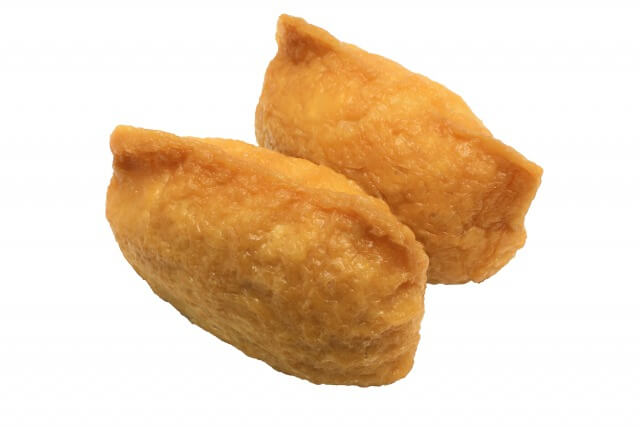

Inari sushi was made in the Edo period.
いなり寿司は、江戸時代には作られていました。
- Inari sushi/いなり寿司
- made/make(作る)の過去形・過去分詞
- Edo period/江戸時代
There is a description about Inari sushi in the literature at the end of the Edo period.
江戸時代末期の文献には、いなり寿司についての記述があります。
- description/記述
- about/~について
- Inari sushi/いなり寿司
- literature/文献
- at the end of/~の終わりに
- Edo period/江戸時代
The paintings written at the end of the Edo period also include paintings of merchants selling inari sushi.
江戸時代末期に書かれた絵には、いなり寿司を売る商人の絵も描かれています。
- painting/絵
- written/write(書く)の過去分詞
- at the end of/~の終わりに
- Edo period/江戸時代
- also/~もまた
- include/含む
- of/~の
- merchant/商人
- sell/売る
- inari sushi/いなり寿司
At the end of the Tokugawa shogunate, some shops selling inari sushi appeared and became popular with the general public.
幕末になると、いなり寿司を売る店も現れ、庶民の人気となりました。
- at the end of/~の終わりに
- Tokugawa shogunate/徳川幕府
- some/いくつか
- shop/店
- sell/売る
- inari sushi/いなり寿司
- appear/現れる
- became/become(なる)の過去形
- popular with/~に人気の
- general public/庶民



(随分と昔からあるお寿司なのね。)
いなり寿司(おいなりさん)の名前の由来を英語で説明
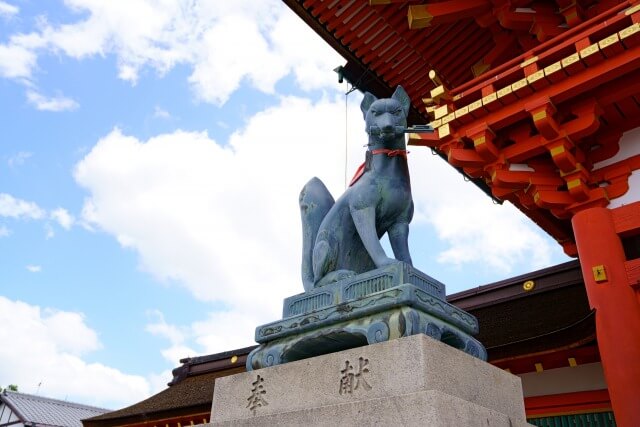

There are various theories about the origin of the name Inari sushi.
いなり寿司の名前の由来には、色々な説があります。
- various/色々な
- theory/説
- about/~について
- origin/由来
- name/名前
- Inari sushi/いなり寿司
The theory is that the fried tofu used for inari sushi is a favorite of the fox, the messenger of the Inari god.
いなり寿司に使う油揚げは、稲荷神の使いである狐の好物だから、という説が有名です。
- famous/有名な
- theory/説
- fried tofu/油揚げ
- use/使う
- for/~に
- inari sushi/いなり寿司
- favorite/好物
- fox/狐
- messenger/使い
- Inari god/稲荷神
There is also a theory that Inari sushi was offered at the Inari Shrine, which enshrines the god of farming, Inari, with gratitude and wishes for a good harvest.
豊作への感謝と願いを込めて、農耕の神である稲荷神を祀る稲荷神社にいなり寿司がお供えされたから、という説もあります。
- also/もまた
- theory/説
- Inari sushi/いなり寿司
- offer/お供えする
- Inari Shrine/稲荷神社
- enshrine/祀る
- god/神
- farming/農耕
- Inari/稲荷
- with/~とともに
- gratitude/感謝
- wishe/願い
- for/への
- good harvest/豊作
There is also a theory that it was because vinegared rice was stuffed in the fried tofu that was offered to Inari God.
稲荷神にお供えしてあった油揚げの中に酢飯を詰めたから、と言う説もあります。
- also/もまた
- theory/説
- because/だから
- vinegared rice/酢飯
- stuff/詰める
- fried tofu/油揚げ
- offer/お供えする
- Inari God/稲荷神



(稲荷は狐の好物なのね。)
いなり寿司(おいなりさん)の味付けや形の違いを英語で説明
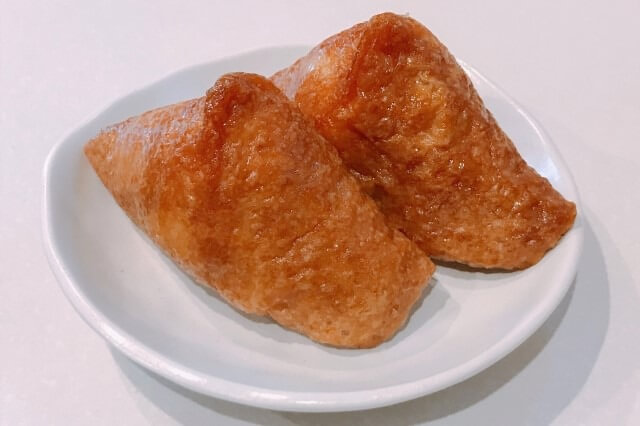

The seasoning of fried tofu tends to be stronger in the eastern part of Japan and lighter in the western part of Japan.
油揚げの味付けは、日本の東側の地域ほど濃く、西側の地域ほど薄い傾向があります。
- seasoning/味付け
- fried tofu/油揚げ
- tend to/~の傾向がある
- strong/濃い
- eastern/東
- part/側
- Japan/日本
- light/薄い
- western/西
This is because the colder the region, the stronger the seasoning, and the warmer the region, the lighter the seasoning.
これは、寒い地方ほど味付けが濃く、温かい地方ほど味付けが薄くなるためです。
- because/~だから
- cold/寒い
- region/地方
- strong/濃い
- seasoning/味付け
- warm/温かい
- light/薄い
The shape of inari sushi is generally square in the eastern part of Japan and triangular in the western part of Japan.
いなり寿司の形は、日本の東側の地域では四角、西側の地域では三角の形が一般的です。
- shape/形
- inari sushi/いなり寿司
- generally/一般的に
- square/四角
- eastern/東
- part/側
- Japan/日本
- triangular/三角
- western/西
It is said that the squares represent the shape of rice bales and the triangles represent the fox ears.
四角は米俵の形、三角はキツネの耳を表していると言われています。
- it is said that/~と言われている
- square/四角
- represent/表す
- shape/形
- rice/米
- bale/俵
- triangle/三角
- fox/キツネ
- ear/耳



(地方によって味付けや形が違うのね。)
いなり寿司(おいなりさん)の作り方を英語で説明
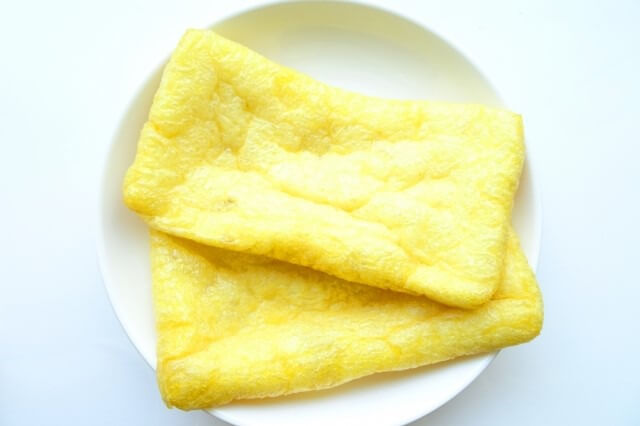

First, simmer the fried tofu with soup stock, soy sauce, and sugar.
最初に、油揚げを、だし汁と醤油と砂糖でコトコト煮込みます。
- first/最初に
- simmer/コトコト煮込む
- fried tofu/油揚げ
- with/~で
- soup stock/だし汁
- soy sauce/醤油
- sugar/砂糖
Mix rice vinegar, sugar and salt with cooked rice and let it cool to make vinegar rice.
炊いた米に、米酢と砂糖と塩を混ぜ、冷まして酢飯にします。
- mix/混ぜる
- rice vinegar/米酢
- sugar/砂糖
- salt/塩
- with/~と
- cooked/調理した
- rice/米
- let/~させる
- cool/冷める
- make/作る
- vinegar rice/酢飯
When mixing ingredients with vinegared rice, mix the seasoned ingredients with vinegared rice.
酢飯に具材を混ぜる場合は、味付けをした具材を酢飯に混ぜます。
- when/時
- mix/混ぜる
- ingredient/具材
- with/~と
- vinegared rice/酢飯
- seasoned/味付けした
- ingredient/具材
- vinegared rice/酢飯
Squeeze the fried tofu and stuff the vinegared rice into the fried tofu.
油揚げの煮汁を絞り、酢飯を油揚げに詰めます。
- squeeze/絞る
- fried tofu/油揚げ
- stuff/詰める
- vinegared rice/酢飯
- into/~の中に
- fried tofu/油揚げ



(油揚げをコトコト煮込んでから、油揚げの中に酢飯を詰めるのね。)
いなり寿司(おいなりさん)を英語で説明|まとめ
いかがでしたでしょうか?
外国人にとって寿司といえば、握り寿司をイメージする人が多いと思います。
そのため、いなり寿司は、あまり外国人には馴染みがないかもしれません。
お寿司なのに、鮮魚が入っていないということも、外国人は驚くかもしれません。
いなり寿司は酢飯を醤油や砂糖で味付けした油揚げに詰めたお寿司であること、稲荷とはきつねや稲荷神、稲荷神社に由来していることを、外国人にも分かりやすく英語で説明してみてください。










